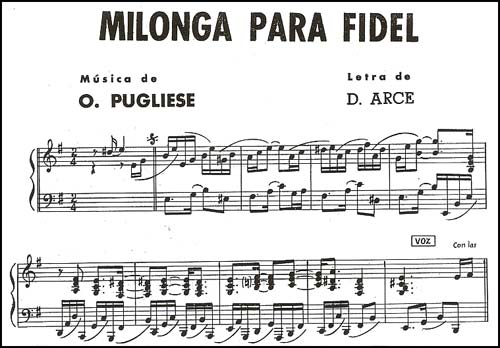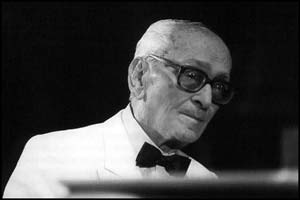By
Milonga para Fidel, Castro in the tango repertoire

idel Castro is one of the few political personalities who, not being Argentine, has a place in the history of tango thanks to a scarcely known milonga that the pianist and orchestra leader Osvaldo Pugliese composed to pay homage to the former and recorded with his orchestra in the early 60’s, and which more than fifty years later is still a mystery for the researchers of the genre.
With lyrics by D. Arce (sobriquet used by the violinist Domingo Arcidiácono), “Milonga para Fidel” was composed, published and recorded between the late 1960 and the early 1961, but was never commercially released and even today there is hard to find any reference about it in books, biographies, anthologies and discographic surveys about Pugliese and tango in general.

A short reference in the Terapia Tanguera website (http://bit.ly/2o3Uc9y) holds that «the sheet music was published in 1961 and nearly all its copies were destroyed in breaking and entering procedures made by the Federal Police», but it states that Pugliese’s latter wife, Lidia Elman: «owns one of the copies and another is in possession of Fidel Castro».
According to an article about Pugliese published in 2010 on the Internet site of the Argentine Communist Party, the musician gave Castro the sheet music «in one of his visits to the island», an occasion on which both men «talked for many hours» because «Fidel wanted to hold him and hear more about his life» in spite of the fact that «Osvaldo did not like to waste Castro’s time».
Terapia Tanguera also contributed the only facsimile copy of the printed sheet music, in which we can read that it was published in 1961.
 However, as a portion of the pressmark is outside the scanned area and there are no available images of the front cover, it is not clear if it was published by some music publisher or if it was a private release.
However, as a portion of the pressmark is outside the scanned area and there are no available images of the front cover, it is not clear if it was published by some music publisher or if it was a private release.
In the Sociedad Argentina de Autores y Compositores de Música (SADAIC), the “Milonga para Fidel” was filed in the record on September 9, 1975 and Pugliese only appears as composer, as if the piece were an instrumental, according to the database of music pieces available in the Internet site of the institution, in which Arcidiácono appears with 33 numbers (in some as lyricist, in others as composer and in others in both capacities).
A recording of the “Milonga para Fidel” attributed to the Pugliese orchestra with Jorge Maciel and Alfredo Belusi on vocals, and supposedly recorded for Stentor, a label that the pianist himself founded in 1960 after splitting with Odeon, circulates among record collectors and tango scholars.
A discographic research published by the El Tango y Sus Invitados website places the “Milonga para Fidel” between “Sueño malevo”, the last of the 12 recordings that Pugliese made in Stentor in 1960 and were published in a long-playing record, and “Corrientes bajo cero”, the first one he cut for the Philips Company, in 1961.
 Due to the longtime and public Pugliese’s joining the Argentine Communist Party, of which he had been member since 1936, it seems reasonable to think that the “Milonga para Fidel” was composed after Castro declared, in 1961, the Marxist character of the Cuban revolution.
Due to the longtime and public Pugliese’s joining the Argentine Communist Party, of which he had been member since 1936, it seems reasonable to think that the “Milonga para Fidel” was composed after Castro declared, in 1961, the Marxist character of the Cuban revolution.
What it turns out hard to understand is that 50 years later, when Cold War and censorship to popular songs are so faraway memories, this milonga –which words are not an example of poetical quality and even contains an evident mistake in the meter, but as a curiosity it is much better than tens of tangos which are habitually heard- keeps on being in reality hidden today.